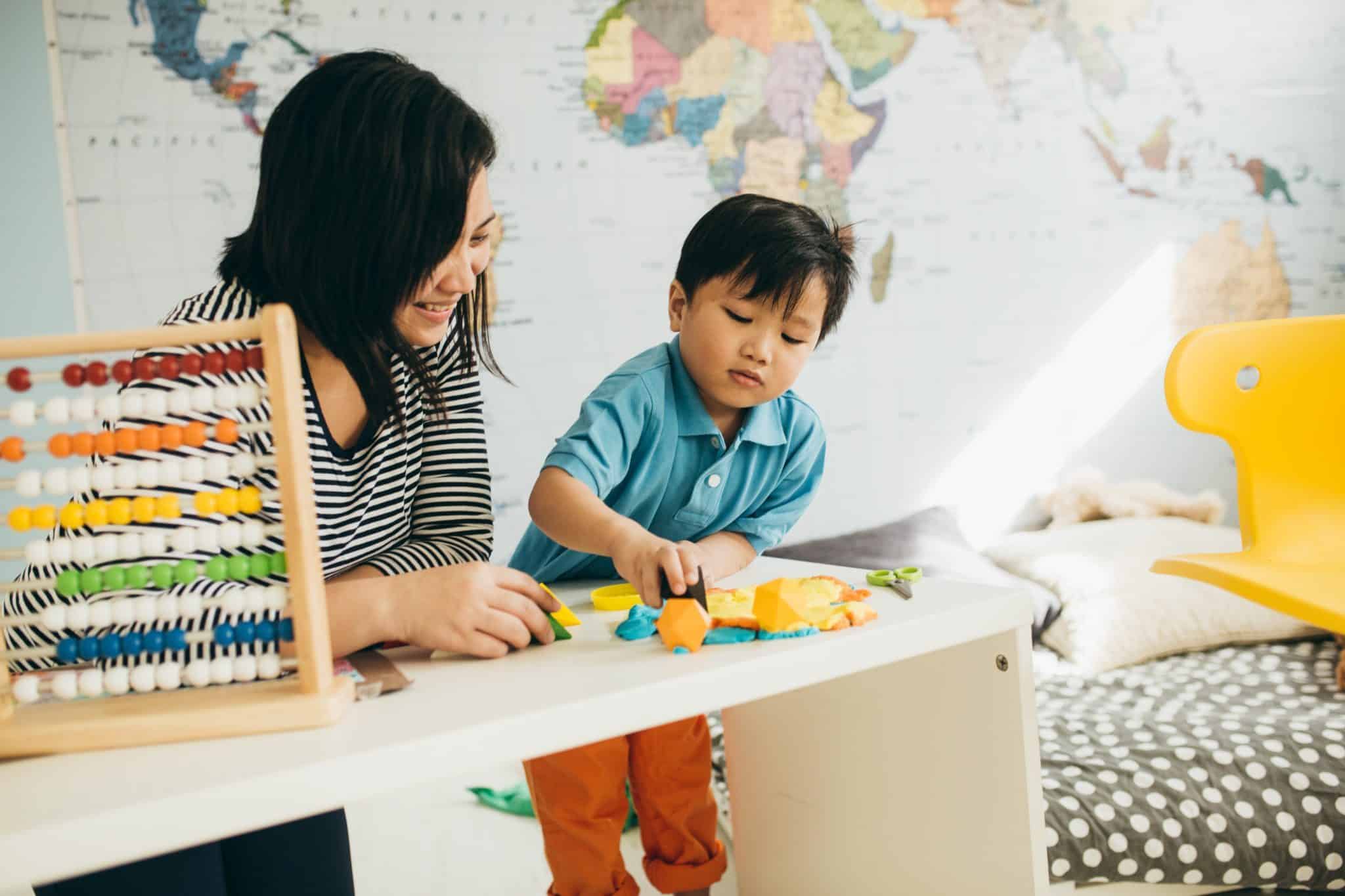MED-EL, MaryKay Therres
Published Jul 29, 2016
5 Games to Encourage Your Child to Make First Sounds
Once your child has their cochlear implant and can hear their own voice, they will begin to play with making their first sounds. This is the perfect time to encourage your child to learn and make new sounds, which will lead to making their first words!

We posted about the Four Stages of Building Your Child’s Auditory Skills before, which included tips on connecting sound with meaning. In this post, we share tips for encouraging sounds, responding to your child, and ideas for playing with new sounds. Firstly, to understand making words or speech, let’s break down the different types of making sound. The stages outlined below describe the progress for normally developing children. Once your child can hear sounds with their cochlear implant, you can use these stages below as a guide to find out where your child is at. If your child was implanted later, it is useful to know these stages as they will also go through these, but know that the time frame can be slightly different for each child.
Speech Production for Normally Developing Children
Speech production for normally developing children can be described in the following steps:
- 0–1 month: crying, fussing, burping
- 2–3 months: beginning to use some long vowel-like sounds
- 4–6 months: uses more vowel-like and consonant sounds; plays with pitch and loudness; experiments by producing raspberries, tongue clicks etc
- 7–9 months: repeats the same consonant and vowel (e.g. ba ba ba, ada ada); starts to sound more like adult words
- 10–12 months: makes different adult-like vowels and consonants in random order (e.g. badeemoma); the range of sounds increases
- 12–18 months: jumbled sounds with some true words
These stages are essential to your child learning how to produce sounds. This will lead to their first words and will help your child to speak clearly as they get older.
Games to Encourage Your Child to Make First Sounds
Listed below are some games that you can play with your child to help their learning.
Hands-on Play
- While you are sitting, have your child sit in your lap facing you with your arms supporting their back. Lower your child to your knees while saying “Doooooown” with a strong voice. Then bring them back up to a sitting position while saying “Up up up”.
- After repeating the activity a few times, pause before you either lower or bring your child back up and wait to see if they show that they want you to do it again. If your child makes any sound, encourage them! This can be an imitation of the sound, or something like, “Yes, you want to come up. Up, up up.”
Play with Toys
Toys such as animals or cars are a great way to build your child’s communication skills, as children are more likely to make sounds or try to talk while they are playing with a toy that they like.
- Choose a toy your child likes. As you make the toy “hop” repeatedly, make a repeated sound: “hop hop hop”. Use a different sound with each object.
- When pushing the toy along a floor or table top, produce a longer sound that matches the object: “brmmm” for a truck and “aaaaahhh” for a plane.
- Change the toys using shorter and longer sounds to expose your child to a range of sounds and rhythms.
- If you have two of the same toy, such as cars, take one for yourself and give one to your child. As you make a sound, you can look expectantly at your child encouraging them to imitate. If you have just one of the toys, make the sound and hand it to your child immediately afterwards, and look expectantly for them to repeat your sound. If your child does not repeat the sound, don’t worry, just continue to make sounds with the toy. Some children take more time to listen before they start to make any sounds.
Play with Sounds Representing Animals or Objects
There are sounds that relate directly to an object or thing, such as: “baa baa baa” for a sheep, “beep beep” for a car. These sounds encourage your child to attach meaning to familiar objects and help them to make their first sounds. Use a toy that has a sound that goes with it.
As you play with the toy and move it around your play area, make the matching sound. Hand the toy to your child and encourage them to make the same sound. Examples of toys to use:
- Cow: moo
- Cat: meow
- Dog: woof woof
- Sheep: baa baa baa
- Horse: neigh
- Bird: peep peep
- Any food item: mmm
- Ball: bounce bounce bounce
- Airplane: ahhhhh
- Boat: buhbuhbuh
- Firetruck: oooooooo (siren sound)
- Train: choo choo or woo woo
Use Household Objects
All kinds of everyday objects around the home work well in creative play and can be used to teach your child new first sounds!
- Using a marker, make dots on paper while saying a simple consonant-vowel sequence each time you make the dot on the paper, for example: “na na na”.
- Draw a long line on the paper and make a long sound as you are drawing it, say “eeeeeeee, sooooooooooo”. Give your child a marker at the same time and encourage them to make the same sound as you.
Find some simple string and beads.
- As you put a bead on a string, make either a repeated sound or a long sound as you slide it down the string.
- Take turns with your child in putting beads on the string and encourage your child to make a certain sound as they move the bead down the string.
Use Books or Music
Books and songs are easy and effective ways to encourage sounds from your child, particularly those that use the same words over and over.
- When sharing a book, point out objects, actions and animals and say the sounds that go with them. Encourage your child to repeat what you say. Your child may then say a sound spontaneously as they become more familiar with the book. For example, when reading a book, say ‘oooooopen’ with lots of exaggeration every time you open a flap in the book.
Encourage your child to also make sounds as you do this. If you turn a page and the character you’re looking for, for example a dog, isn’t in the picture, you can say “uh oh, where are they?” encouraging your child to again make sounds. Every time you see the character you can say “woof woof woof”, or “hello!” - Encourage your child to ‘sing’ along with familiar songs. The song “Old MacDonald” has great sounds to play with like“e-i-e-i-o”.
These are just a few ideas to get you started when encouraging your child to play with different sounds, which will lead to first words. Most importantly: be imaginative and have fun!
References


MED-EL
MaryKay Therres
MaryKay Therres (MSc., CCC-SLP, LSLS Cert. AVT, AST Therapist) is a Speech-Language Pathologist who has over 30 years of experience working with individuals who use hearing technology. She is the Senior Manager of Education and Rehabilitation for MED-EL Headquarters.
Was this article helpful?
Thanks for your feedback.
Sign up for newsletter below for more.
Thanks for your feedback.
Please leave your message below.
Thanks for your message. We will reply as soon as possible.
Send us a message
Field is required
John Doe
Field is required
name@mail.com
Field is required
What do you think?
© MED-EL Medical Electronics. All rights reserved. The content on this website is for general informational purposes only and should not be taken as medical advice. Contact your doctor or hearing specialist to learn what type of hearing solution suits your specific needs. Not all products, features, or indications are approved in all countries.


MED-EL
MaryKay Therres
MaryKay Therres (MSc., CCC-SLP, LSLS Cert. AVT, AST Therapist) is a Speech-Language Pathologist who has over 30 years of experience working with individuals who use hearing technology. She is the Senior Manager of Education and Rehabilitation for MED-EL Headquarters.

MED-EL

MaryKay Therres
MaryKay Therres (MSc., CCC-SLP, LSLS Cert. AVT, AST Therapist) is a Speech-Language Pathologist who has over 30 years of experience working with individuals who use hearing technology. She is the Senior Manager of Education and Rehabilitation for MED-EL Headquarters.


